
Amblypygi is an order of arachnids also known as whip spiders or tailless whip scorpions, not to be confused with whip scorpions or vinegaroons that belong to the related order Thelyphonida. The name "amblypygid" means "blunt tail", a reference to a lack of the flagellum that is otherwise seen in whip scorpions. Amblypygids possess no silk glands or venomous fangs. They rarely bite if threatened, but can grab fingers with their pedipalps, resulting in thorn-like puncture injuries.

The Brandberg is Namibia's highest mountain.

Gigantometrus Swammerdami, commonly called the giant forest scorpion, is a scorpion belonging to the family Scorpionidae. It is native to India and is the world's largest scorpion species with 23 cm in length, and weighs 56 g (2.0 oz).

The Buthidae are the largest family of scorpions, containing about 100 genera and 1339 species as of 2022. A few very large genera are known, but a high number of species-poor or monotypic ones also exist. New taxa are being described at a rate of several new species per year. They have a cosmopolitan distribution throughout tropical and subtropical environments worldwide. Together with four other families, the Buthidae make up the superfamily Buthoidea. The family was established by Carl Ludwig Koch in 1837.

Centruroides is a genus of scorpions of the family Buthidae. Several North American species are known by the common vernacular name bark scorpion. Numerous species are extensively found throughout the southern United States, Mexico, Central America, the Antilles and northern South America. Some are known for their interesting patterning or large size ; most if not all fluoresce strongly under ultraviolet illumination, except after moulting. They contain several highly venomous species, and fatalities are known to occur. The venom of the Mexican scorpion Centruroides limpidus limpidus contains the neurotoxins Cll1 and Cll2.
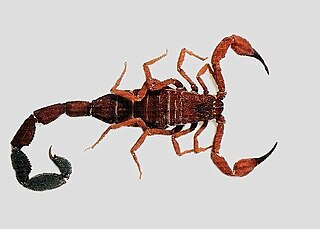
Tityus is a large genus of thick-tailed scorpions, the namesake of its subfamily Tityinae. As of 2021, Tityus contains more than 220 described species distributed in Central America and South America, from Costa Rica to Argentina. Species in the genus Tityus have been studied for hundreds of years, long before the taxonomic classification was put in place. Tityus tend to be of medium size for scorpions, roughly 50 to 70 millimeters long. They are dark brown or red in color, and can exhibit sexual dimorphism. They can live in a variety of environments, ranging from urban to arid mountains to the Amazon Rainforest. Tityus scorpions are best known for their venom and potent sting. The genus contains several dangerously venomous scorpions, the best known of which is the Brazilian yellow scorpion, T. serrulatus. Its venom can cause severe illness, and in the young, old and infirm even death. Some experts have argued that the genus as a whole may be paraphyletic, which could explain the knowledge gaps related to Tityus.

Hottentotta tamulus, the Indian red scorpion, also known as the eastern Indian scorpion, is a species of scorpion of the family Buthidae. It occurs in most of India, eastern Pakistan and the eastern lowlands of Nepal, and recently from Sri Lanka.
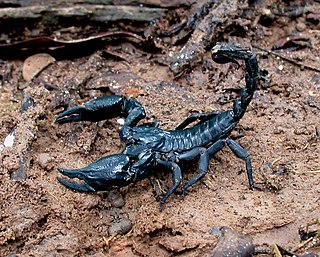
Heterometrus, whose members are also known by the collective vernacular name giant forest scorpions, is a genus of scorpions belonging to the family Scorpionidae. It is distributed widely across tropical and subtropical southeastern Asia, including Indonesia, Brunei, Malaysia, Myanmar, Philippines, Singapore, Cambodia, Laos, Thailand, Vietnam, India, and China (Hainan). It is notable for containing some of the largest living species of scorpions.
Birtoxin is a neurotoxin from the venom of the South African Spitting scorpion. By changing sodium channel activation, the toxin promotes spontaneous and repetitive firing much like pyrethroid insecticides do
BmKAEP is a neurotoxin from the venom of the Manchurian scorpion (Mesobuthus martensii). It is a β-toxin, which shift the activation voltage of sodium channels towards more negative potentials.

Olivierus martensii is a species of scorpion in the family Buthidae. Its common names include Chinese scorpion, Manchurian scorpion, Chinese armor-tail scorpion and Chinese golden scorpion. Despite its common name, this scorpion is not only found in Manchuria or China, but also in Mongolia and Korea. The record from Japan is doubtful. Its preferred habitat is warm, dry areas with little vegetation. O. martensii can grow to about 6 centimetres (2.4 in) long, with females usually slightly larger, and has a life-span of about 4 to 6 years.
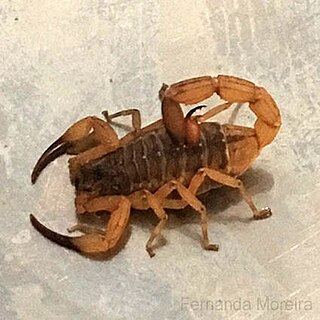
Tityus serrulatus, the Brazilian yellow scorpion, is a species of scorpion of the family Buthidae. It is native to Brazil, and its venom is extremely toxic. It is the most dangerous scorpion in South America and is responsible for the most fatal cases.

Uroplectes is a genus of scorpions in the family Buthidae. They are known commonly as the lesser thick-tailed scorpions. There are about 40 species distributed in the Afrotropical realm. They are most diverse in South Africa.

Parabuthus, commonly known as the thick-tailed scorpion, is a genus of large and highly venomous Afrotropical scorpions, that show a preference for areas of low rainfall. Their stings are medically important and human fatalities have been recorded.
Parabuthus brevimanus is a species of scorpion from southern Africa, that ranges from southern Angola to Namibia and western South Africa, where its range extends south of the Orange River.

Srilankametrus indus, commonly known as the giant forest scorpion, is a species of scorpions belonging to the family Scorpionidae. It is native to India and Sri Lanka.
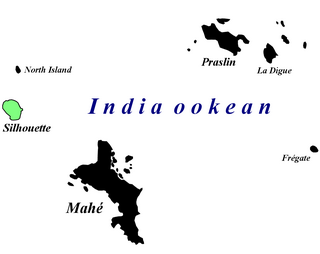
Afrolychas braueri, commonly known as the Seychelles forest scorpion, is a species of scorpion in the family Buthidae. It is currently thought to survive only on Silhouette Island, Seychelles, although the species was historically found on two additional Seychellois islands. This scorpion lives in leaf litter in forests that are largely unaffected by invasive plant species. It is a small yellowish-brown scorpion with three prominent keels on the dorsal surface of its mesosoma, which distinguishes it from other scorpions. While not much is known about the Seychelles forest scorpion's ecology due to the paucity of sightings, it is known to rely solely on its venom to capture its prey and defend its young. Its venom is not dangerous to humans.
Uroplectes ansidippenaarae is a species of scorpion in the family Buthidae, endemic to South Africa. It is the smallest member of the genus Uroplectes.
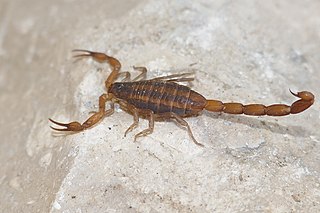
Centruroides hentzi, the Hentz striped scorpion, is a species of bark scorpion in the family Buthidae. They are native to the southeastern United States including the states of Florida, southwestern Alabama, and in the coastal plain of Southern Georgia including surrounding barrier islands. C. hentzi is present in other states such as North Carolina and South Carolina due to accidental human importations.
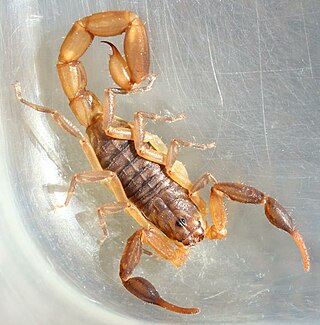
Pseudolychas is a genus of scorpion in the family Buthidae. Species of the genus are known as the pygmy-thicktail scorpions and are found in South Africa, Eswatini and Mozambique. Their venom is mild and not medically important.
















